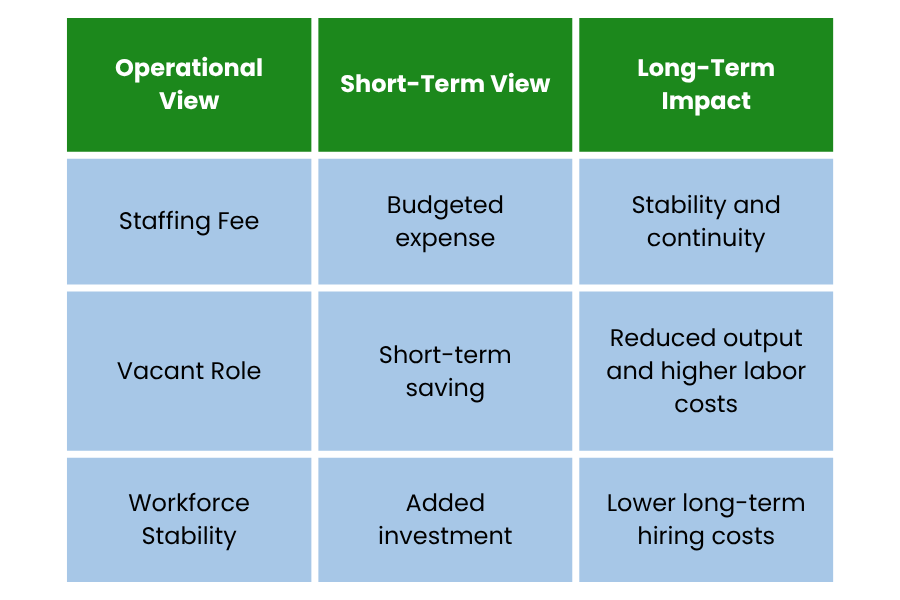
Why Empty Seats Are More Expensive Than Staffing Fees
Employers across manufacturing, construction, hospitality, and automotive face the same issue: unfilled roles cost more than most realize. While it’s easy to see what a staffing fee costs on paper, it’s harder to see the cost of job vacancy and the quiet losses that build each day a position stays open.
When essential roles remain empty, production slows, overtime increases, and workloads shift unevenly. These disruptions affect more than just the schedule; they also strain teams and reduce output. The longer the vacancy, the more expensive recovery becomes.
A Forbes report found that companies lose an estimated $7,000 to $10,000 per month when revenue-generating roles go unfilled. Those costs compound when vacancies delay production, limit service capacity, or stretch the existing teams thin. Filling those seats quickly protects operations and keeps performance steady.
Staffing fees are predictable. Vacancy costs are not. Filling roles quickly is not about spending more; it is about protecting the work already in production and maintaining operations.
The Hidden Cost of Doing Nothing
Every open position carries a vacant position impact. When roles remain unfilled, the effect is felt across the entire operation. Productivity dips, shifts run longer, and employees take on added responsibilities to cover the gap. Over time, that pressure leads to burnout and higher turnover.
Industry research estimates the average cost of a single hire at roughly $5,000, and only represents the hiring process. It does not include the productivity lost while the position stays empty. Each week of delay adds more strain and lowers efficiency across the team.
Leaving a position open might seem like saving money, but the opposite is true. Every day a key role stays vacant, it increases risk of turnover and reduces profitability. Filling positions quickly is not an added expense; it is how employers protect stability and keep operations running at full capacity.
Industry Impact: Where Empty Seats Hurt Most
Every industry feels the effects of unfilled roles differently, but the result is the same: slower operations, higher costs, and added pressure on existing staff. Here’s how vacant position impact plays out across key industries.
Manufacturing
In manufacturing, one open position can disrupt the entire line. When a single station is short-staffed, production targets slip, overtime grows, and orders fall behind. Skilled technicians, machine operators, and maintenance staff keep facilities efficient. Filling those roles quickly protects output and helps prevent costly downtime.
Construction and Skilled Trades
On a job site, timing drives profitability. A single unfilled trade position can stall multiple crews and delay an entire project. Idle equipment, rescheduled inspections, and contract penalties all cut into profits.
Vacant trade roles rarely affect only one task. When a welder or electrician is missing, progress slows across the site. Reliable staffing helps contractors avoid delays and keep projects on track.
Hospitality and Food Service
Hotels, resorts, and restaurants rely on steady staffing to maintain service quality and customer satisfaction. The U.S. Bureau of Labor Statistics projects accommodation and food service employment will grow from 12.6 million in 2024 to 14.2 million by 2034. That growth reflects stronger demand across the industry, but many employers still face persistent labor shortages, making it harder to find and retain the workers needed to meet that demand.
When kitchens or housekeeping teams run short, guest experiences suffer and revenue opportunities are lost. Consistent staffing keeps service smooth and guests coming back.
Automotive and Logistics
In logistics and automotive production, one open position can slow an entire system. Delays in shipping, quality control, or warehouse operations create ripple effects that impact deliveries and profitability. Keeping every role filled helps maintain steady output and dependable performance across the operation.
Reframing the Real ROI
Many leaders see what they spend on hiring, but not what it costs when a position stays empty. The ROI of staffing becomes clear when you compare a one-time fee to the ongoing impact of an unfilled role. A staffing fee is a known cost. An open seat keeps costing you in slower production, missed deadlines, and overtime that builds up.
Finance teams often track ROI in revenue gained, but the true ROI comes from avoiding these losses. Filling roles faster reduces overtime, protects schedules, and maintains customer satisfaction. The predictable cost of hiring is smaller than the unpredictable cost of delay.

Staffing is not an expense; it is protection for your productivity and long-term stability. Filling essential roles keeps operations steady and helps the business stay on track.
Treat Staffing as Insurance for Stability
A full team keeps productivity strong and downtime low. When every role is covered, employees can focus on the work ahead instead of making up for gaps. By treating staffing as insurance, employers create steady operations that stay prepared for whatever comes next.
Good Labor Jobs connects employers with verified, ready-to-work U.S. citizens, including skilled professionals from Puerto Rico. Housing and transportation support are built into every placement, helping workers arrive on time and stay through the season. This approach keeps operations steady and safeguards investments in people and equipment.
Keep every role filled and every shift covered. Connect with Good Labor Jobs to secure the workforce that keeps production on pace and downtime low.















